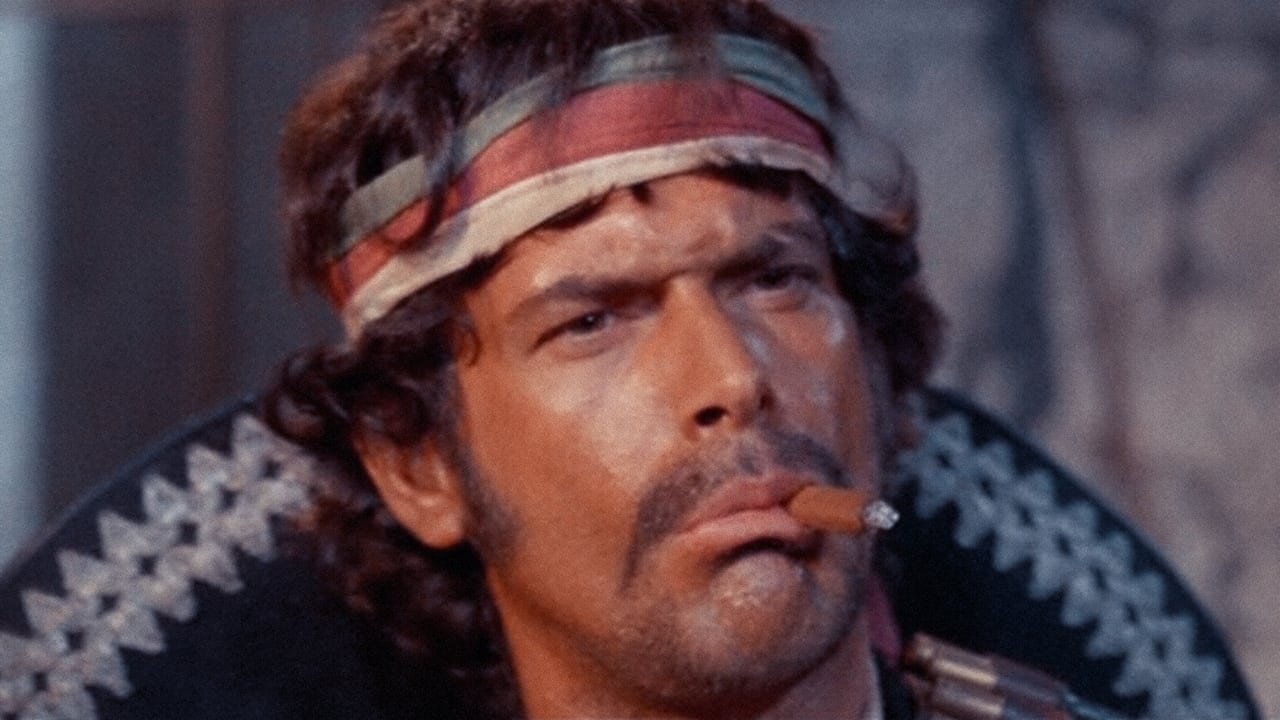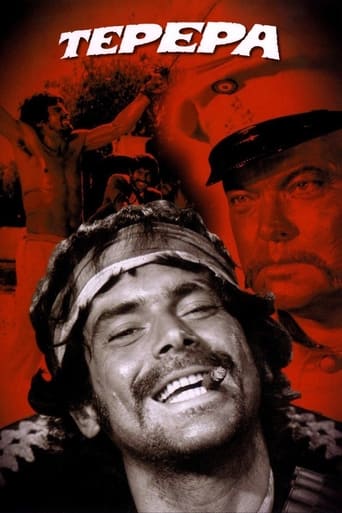



Truly Dreadful Film
It's entirely possible that sending the audience out feeling lousy was intentional
View Moreit is the rare 'crazy' movie that actually has something to say.
View MoreOne of the best movies of the year! Incredible from the beginning to the end.
View MoreThe movie centers on a Mexican revolutionary nicknamed Tepepa (a likable Tomas Milian) who joins forces an outlaw band during the Mexican revolutionary war by time of the president Madero (played by a Spaghetti usual secondary , Francisco Sanz) . The Mexican guerrilla leader Tepepa wielding his Mauser gun and his gang fight against colonel Cascorro (special appearance of Orson Welles). When illiterate Tepepa is about to be executed , there appears a serious and smooth-talking British doctor named Henry Price (the blond John Steiner) and saves him from a firing squad . Later on , starring duo , Milian-Steiner , undergo a strange relation of friendship and hatred . But someone prepares a relentless vendetta on a surprising final .It's a magnificent western film with dazzling shootouts between the protagonists and the contenders . This film belongs to the numerous group that are set during the Mexican revolution , called ¨Zapata Western sub-genre¨ , like are the Italian ones : ¨ Duck you sucker¨ ,¨Compañeros¨ , ¨The mercenary ¨ and the Americans : ¨The wild bunch and ¨The professionals¨. ¨Tepepa¨ results to be the swan-song of this sub-genre . The picture blends violence , western action , plot twists and shoot'em up with high body-count . ¨Tepepa¨ is fast movement and that's why it is entertaining ; besides , there is thoughtful dialog with an intelligent writing by Franco Solinas , an author of communist ideology who wrote political screenplays such classics as ¨The battle of Argel¨ and ¨I'm the Revolution¨ , the latter bears remarkable resemblance on some issues to ¨Tepepa¨ . The Cuban Tomas Milian , as usual , puts faces , grimaces , crying and overacting , but he plays splendidly in a similar character to ¨Cuchillo¨ from the trilogy directed by Sergio Sollima . Tomas created his own image and propelled himself to stardom in likewise fashion with such important Spaghetti movies as The Bounty Killer (1966) , The Big Gundown (1967) with Lee Van Cleef , Face to Face (1967) , Django Kill! (1967) and Run, Man, Run (1968). Enjoyable score by the great maestro composer Ennio Morricone who composed lots of Spaghetti Western scores , it contains a sensitive musical leitmotif . There are many fine technicians and nice assistants as the splendid cameraman Francisco Marin who makes an atmospheric photography , including barren outdoors , dirty landscapes under a glimmer sun , being shot , of course , on location in Almeria , Spain . However , being necessary and perfect remastering because of the original copy is worn-out . The motion picture was well directed by Giulio Petroni who filmed another classic Italian western as ¨Death rides a horse¨ , though also shot other inferior but acceptable Spaghettis as ¨Night of serpent¨ and ¨A sky full of stars for a roof¨. Rating : Above average S.W. , worthwhile seeing .
View MoreThe American version of "Death Rides A Horse" director Guilio Petroni's "Tepepa" qualifies as utterly egregious. Something is missing because everything seems truncated, and the European cut runs about twenty minutes longer. Mind you, this realistic but adventurous Italian Spaghetti western about the Mexican revolution resembles later westerns, such as Sergio Corbucci's "The Mercenary," Sergio Corbucci's "Companeros," Damiano Damiani's "A Bullet for the General," and Sergio Leone's "Duck, You Sucker." Unfortunately, watching the VHS copy is like looking through a keyhole at life because this was filmed in Techniscope at 2.35.1 so each shot looks spectacular. During the letterboxed opening credits sequence, the visual compositions of "The Texican" lenser Francisco Marín are breathtaking, endowing this mangled Spaghetti with great look. Nevertheless, despite its being mutilated, "Tepepa" looks like it might be a good movie. The peasant army ambush of the Mexican Army is nothing short of brilliant. Orson Welles makes a genuinely menacing villain who is proved better off dead than alive. Not surprisingly, Tomas Milian of "The Big Gundown" makes a charismatic as well as introspective revolutionary leader. We watch the bandit change during the trajectory of the action. The English doctor is the ultimate villain because he never wavers from his vow to kill the Milian revolutionary figure. The theme that recurs through the Franco Silanos screenplay is revenge. Interestingly, Silanos wrote both "The Mercenary" and "A Bullet for the General" so this is familiar turf for him. Everybody seems like they are after revenge, from the outsider British doctor who renounces his oath as a doctor to kill an enemy to the messiah but flawed bandit Tepepa who resumes the revolution when he sees how the Army controls the president. Petroni and Solinas dwell on the injustices wrought by the revolution in the on-going clash of the haves and the have-nots. The ending and the unsavory quality of the British doctor and the Mexican revolutionary may alienate some audiences. This is not a cheerful, but rather a serious Spaghetti western about the disillusion that came with the end of the revolution and the realization that hundreds of good men had died to put a good man into the presidency who was later manipulated by the evil men.Although it ostensibly resembles a western, this Spaghetti belongs to the Mexican Revolution subgenre of political Italian westerns. The third act when Tepepa and his revolutionaries ambush the Mexican Army is is model of economy and violence. Petroni develops tension and suspense in this scene and stages the ambush with flair, right down to explosives soaring into our faces. Moreover, however, are the levels of sophisication that flow within the contours of this terrific scene. As the Army approaches the pass, everybody grows tense and suspicious. Suddenly, everything seem tranquil now because the army column has relaxed itself. The Mexican Colonel thinks about this aloud as relief sweeps over the column when several women driving goats approach from the north. The seasoned officer sees danger where his men now see no danger and he orders them to shoot the women tending the flock. The soldiers shoot them women down, but the goats have had time to infiltrate the column and they are wearing sticks of dynamite. BOOM!Ennio Morricone is a musical sensation. Since he worked with Sergio Leone on "Fistful of Dollars," he created the signature musical sound of the Spaghetti western. The soundtracks that he produced often enhanced an inferior western. The distinctive sound of Morricone is something that nobody could or should imitate. Don't get me wrong, other outstanding composers, like Gianni Ferroi, Luis Enríquez Bacalov, Riz Ortolani, Angelo Francesco Lavagnino, Nico Fidenco, Francesco De Masi and Benedetto Ghiglia, thrived during the Spaghetti western years. The Ennio Morricone orchestral soundtrack is above the maestro's towering standards. The piano rift and the marching music is memorable.
View MoreThe American video release of Tepepa does the film no favours. Apparently suffering drastic cuts (40 minutes!) from its continental version, the film now makes little sense. Additionally, the pan and scan print seriously compromises the original 2.35:1 aspect ratio. Whether the original film was any good is a matter of conjecture: though John Steiner is excellent as a British doctor, Orson Welles mumbles his way through his performance as a Mexican colonel and Ennio Morricone's score is cribbed from his earlier work. Nevertheless, a DVD restoration seems absolutely necessary--we can't pass judgment on this film until we see it at full length and in widescreen.
View More1st watched 9/1/2001 - 3 out of 10(Dir-Giulio Petroni): Culture shock seemed to occur for me while watching this movie. I get the impression that if I was from Mexico or another country that experience the kind of life that was displayed in this movie I would have appreciated it more. I could not understand the emphasize on the title character(Tepepa) as a hero(consistently playing this silly come on let's get behind him music) as he goes about fighting for what I guess is freedom from tyrannical rule. The tyrannical ruler of this movie(played by Orson Welles) is emotionless and just not very impressive as a person but supposedly because he had the money he could rule over everyone. This is what `Tepepa' was fighting against, but by the end of the movie with both Tepepa and the Orson Welles characters killed we're still not sure whether this country will be ruled by the people or by those who have the money. This to me is the problem with revolutions in general(Enough with the social commentary, back to the movie.). Without Welles this would have been a much better movie. He mumbled his way through many scenes and just seemed misplaced in the film. As a story it actually was somewhat interesting, but as a film and production it was lacking.
View More